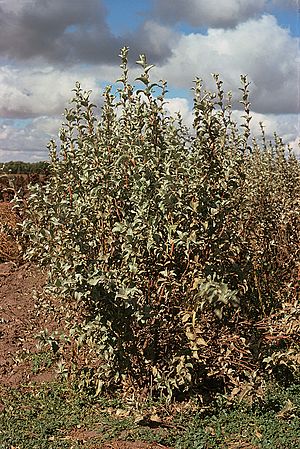Silverberry facts for kids
The silverberry (also known as wolf-willow) is a fascinating plant that grows as a shrub or a small tree. Its scientific name is Elaeagnus commutata. You can find it growing naturally across a large part of North America. This includes areas from southern Alaska all the way to Quebec, and south into states like Utah, South Dakota, and Minnesota.
Quick facts for kids Silverberry |
|
|---|---|
 |
|
| Scientific classification | |
| Genus: |
Elaeagnus
|
| Species: |
commutata
|
Silverberry plants usually prefer dry or slightly moist soils. They often grow in sandy or gravelly areas. You might spot them in open grasslands, meadows, or at the edges of forests.
Contents
What Does Silverberry Look Like?
Silverberry plants can grow to be about 1 to 4 meters (3 to 13 feet) tall. They are either bushy shrubs or small trees.
Leaves, Flowers, and Fruits
The leaves of the silverberry are shaped like a spear. They are usually 2 to 7 centimeters (about 1 to 3 inches) long. What makes them special is their silvery color on both sides. This silver look comes from tiny white scales that cover the leaves.
The flowers are yellow and smell very nice. They have four parts and are about 6 to 14 millimeters (0.2 to 0.5 inches) long.
After the flowers, the plant grows small, oval-shaped fruits. These fruits are about 9 to 12 millimeters (0.3 to 0.4 inches) long. Like the leaves, the fruits are also covered in silvery scales. Inside, the fruit has a floury texture and holds a single seed.
Uses of Silverberry
People grow silverberry for a few different reasons. It's a useful plant for both people and nature!
As an Ornamental Plant
Because of its beautiful silvery leaves, silverberry is often grown as an ornamental plant. This means people plant it in gardens and parks just to make them look pretty. Its unique color stands out!
Edible Parts
Both the fruit and the seeds of the silverberry plant can be eaten. You can eat them raw or cooked. However, the fruit can taste quite sour unless it is fully ripe.
The fruit is packed with good things for you! It's a great source of vitamins and minerals, especially vitamins A, C, and E. It also contains essential fatty acids, which are healthy fats. It's quite rare to find these fats in fruits.
Helping Other Plants Grow
Silverberry is special because it can "fix" nitrogen from the air. This is a process where the plant takes nitrogen gas and turns it into a form that other plants can use as food. This is similar to how legume plants like beans do it.
When silverberry is planted near other fruit trees, it can help them grow better. Some studies have shown that it can even increase the amount of fruit those trees produce by ten percent!
Traditional Uses
In the past, people used the strong, fibrous bark of the silverberry tree. They would twist it to make tough ropes. They also wove the bark into clothing and blankets.
Silverberry and Wildlife
Silverberry is a very important food source for many animals, especially in the winter.
Food for Animals
- Birds: Birds like sharp-tailed grouse and many songbirds enjoy eating the fruits of the silverberry. It's a key food for sharp-tailed grouse during the cold winter months.
- Large Animals: Animals like moose, deer, and elk also rely on silverberry for food. In Montana, silverberry makes up more than a quarter of a moose's diet in winter!
Shelter and Nests
Besides food, silverberry plants also provide safe places for animals. They offer cover and good spots for nesting. For example, mallard ducks and many other small birds use silverberry plants for their nests in North Dakota.
See also
In Spanish: Elaeagnus commutata para niños

